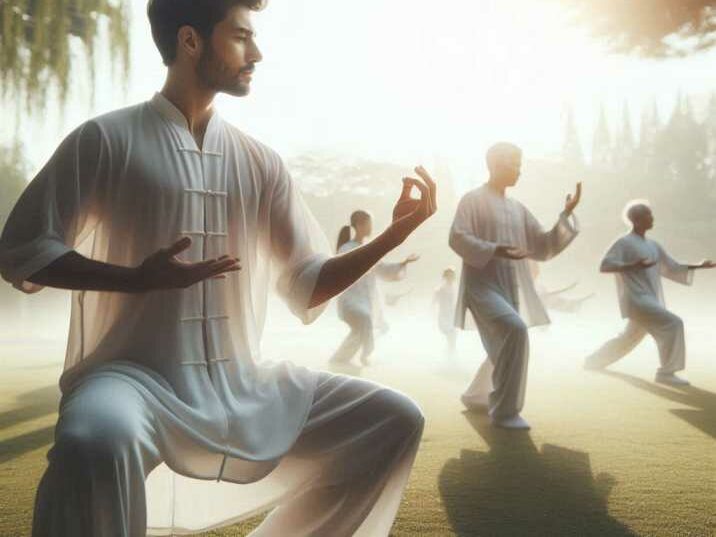Introduction
Table of Contents
Are you curious about the differences between Tai Chi and Chi Kung? Many people are drawn to these ancient Chinese practices for their health benefits, relaxation techniques, and mind-body connection. However, understanding the distinctions and unique features of each can be challenging. In this article, we’ll explore the fascinating histories, philosophies, and practices of Tai Chi and Chi Kung, offering you a comprehensive guide to these disciplines. Whether you’re a beginner looking to start a new practice or someone interested in deepening your knowledge, this guide will provide the insights you need.
What is Tai Chi?
Historical Background
Tai Chi, also known as Tai Chi Chuan, is a martial art that originated in China around the 13th century. It was developed by Chen Wangting, a retired military officer of the Chen village in Henan Province. Tai Chi’s creation was influenced by several sources, including Taoist philosophy, Confucianism, and traditional Chinese medicine.

Philosophy and Principles
Tai Chi is grounded in the Taoist philosophy of Yin and Yang, which emphasizes balance and harmony in life. The practice focuses on cultivating internal energy (Qi) and achieving balance between opposing forces. This philosophy is reflected in Tai Chi’s slow, deliberate movements, which are designed to promote relaxation, concentration, and energy flow.
Key Features and Styles
Tai Chi is characterized by its gentle, flowing movements, deep breathing, and meditation. The main styles of Tai Chi include Chen, Yang, Wu, Sun, and Hao, each with unique forms and techniques. Despite the variations, all styles share common principles such as relaxation, smoothness, and continuity.
What is Chi Kung (Qigong)?
Historical Background
Chi Kung, also known as Qigong, is a practice that dates back thousands of years in China, predating even Tai Chi. It combines physical postures, breathing techniques, and meditation to enhance the flow of Qi throughout the body. Qigong’s roots can be traced back to ancient Chinese medicine, martial arts, and philosophy.
Philosophy and Principles
The fundamental philosophy of Chi Kung revolves around cultivating life energy (Qi) to improve health and well-being. Like Tai Chi, it is influenced by Taoist and Confucian principles, but it is also deeply rooted in Traditional Chinese Medicine. Chi Kung emphasizes the importance of aligning the mind, body, and breath to achieve physical and mental balance.
Key Features and Types
Chi Kung practices can vary significantly, with thousands of styles and forms. Some focus on health and healing, while others are more martial or spiritual in nature. Common types of Chi Kung include Medical Qigong, Martial Qigong, and Spiritual Qigong. The practices may involve standing, seated, or moving meditation, with techniques tailored to specific goals.
Comparing Tai Chi and Chi Kung
Mind-Body Connection
Tai Chi and Chi Kung both emphasize the integration of mind, body, and spirit. This holistic approach is fundamental to achieving overall well-being. By engaging in these practices, individuals learn to cultivate awareness and mindfulness, fostering a deeper connection between their physical movements and mental states. This mind-body integration promotes a sense of inner peace and balance.
- Mindfulness: Both practices encourage being present in the moment, enhancing awareness of body movements, thoughts, and emotions. This mindfulness aspect contributes to improved concentration and mental clarity.
- Holistic Health: The integration of physical, mental, and spiritual aspects in both Tai Chi and Chi Kung leads to improved overall health and well-being, addressing not just physical fitness but also emotional and psychological health.
Breathing Techniques
Breathing is a crucial component of both Tai Chi and Chi Kung. Controlled, deep breathing helps to enhance the flow of energy (Qi) throughout the body, promoting relaxation and reducing stress.
- Tai Chi: In Tai Chi, breathing is synchronized with movements to ensure a smooth flow of energy. Practitioners focus on abdominal breathing, which encourages relaxation and enhances energy circulation.
- Chi Kung: Breathing techniques in Chi Kung are often more varied and emphasized, with specific exercises designed to cultivate and balance Qi. Techniques like “Buddha’s Breath” or “Reverse Breathing” are commonly used to direct energy flow and enhance vitality.
Energy Cultivation
The cultivation and balancing of Qi, or life energy, is central to both Tai Chi and Chi Kung. The goal is to improve the body’s energy flow, enhancing health and vitality.
- Qi Flow: Both practices aim to remove blockages and promote a smooth, balanced flow of Qi, which is believed to support physical health and emotional stability.
- Vitality and Longevity: Regular practice helps to maintain energy levels, boost immunity, and contribute to longevity by keeping the body’s energy systems balanced.
Philosophical Roots
Both Tai Chi and Chi Kung are deeply rooted in Taoist and Confucian philosophies, emphasizing principles of balance, harmony, and natural flow.
- Taoist Principles: These practices embody the Taoist philosophy of living in harmony with nature and the universe. Concepts such as Yin and Yang (the duality and balance of opposing forces) are integral to understanding the movements and intentions behind Tai Chi and Chi Kung.
- Confucian Influence: The emphasis on discipline, moral integrity, and self-cultivation in Confucianism is reflected in the structured practice and personal development aspects of both arts.
Health Benefits
Practitioners of both Tai Chi and Chi Kung report a range of health benefits, from physical to mental and emotional improvements.
- Physical Health: Improved flexibility, balance, and muscle strength are common outcomes. Both practices help in enhancing cardiovascular health, respiratory function, and joint mobility.
- Mental Clarity: The meditative aspects of both practices lead to enhanced mental clarity, focus, and cognitive function, reducing mental fatigue and improving memory.
- Stress Reduction: Deep breathing and mindful movements contribute to relaxation and stress reduction, promoting a sense of calm and reducing anxiety.
- Emotional Stability: Regular practice helps in regulating emotions, enhancing mood, and fostering emotional resilience and stability.
Differences Between Tai Chi and Chi Kung
Purpose and Focus
Tai Chi and Chi Kung have different primary objectives and focus areas, which influence how they are practiced and perceived.
- Tai Chi:
- Martial Art: Tai Chi is originally a martial art, with techniques developed for self-defense. While many practice it today for its health benefits, it retains martial applications and principles.
- Health and Meditation: Tai Chi also emphasizes meditation and relaxation, promoting health and well-being through its slow, deliberate movements.
- Chi Kung:
- Energy Cultivation: The primary focus of Chi Kung is on cultivating and balancing energy (Qi) for health, healing, and spiritual growth.
- Healing and Spirituality: Chi Kung is often practiced for its therapeutic benefits, with techniques aimed at improving health, addressing specific ailments, and fostering spiritual development.
Movement and Structure
The way Tai Chi and Chi Kung are structured and practiced differs significantly, especially in terms of movement complexity and learning process.
- Tai Chi:
- Choreographed Sequences: Tai Chi involves learning complex sequences of movements known as forms. These forms are choreographed and require precision, coordination, and practice to master.
- Time-Intensive: Mastering Tai Chi forms can take years of practice, as they involve intricate movements that require dedication and consistent practice.
- Chi Kung:
- Simpler Exercises: Chi Kung offers a variety of exercises and techniques that are generally simpler and can be learned quickly. These exercises can be tailored to individual needs and abilities.
- Adaptability: Chi Kung’s flexibility allows practitioners to focus on specific goals, such as health improvement or energy cultivation, without the need for mastering complex forms.
Practice Environment
The environments in which Tai Chi and Chi Kung are practiced can vary, reflecting their differences in structure and focus.
- Tai Chi:
- Group Practice: Tai Chi is often practiced in groups, creating a communal atmosphere that enhances learning and motivation.
- Outdoor Settings: Many practitioners prefer practicing Tai Chi outdoors, in parks or natural settings, to connect with nature and enhance the experience.
- Chi Kung:
- Individual or Group Practice: Chi Kung can be practiced individually or in groups, offering flexibility in terms of practice environment and personal preference.
- Variety of Settings: Chi Kung can be practiced indoors or outdoors, and the practice is adaptable to various environments and circumstances.
Styles and Variations
The diversity of styles and forms in Tai Chi and Chi Kung reflects their unique histories and objectives.
- Tai Chi:
- Five Major Styles: Tai Chi has five major styles—Chen, Yang, Wu, Sun, and Hao. Each style has distinct characteristics, movements, and forms, but all share common principles of balance, fluidity, and relaxation.
- Chi Kung:
- Thousands of Styles: Chi Kung encompasses thousands of styles and forms, each tailored to specific goals such as health, martial, or spiritual objectives. The diversity allows practitioners to find a practice that suits their individual needs and preferences.

Health Benefits of Tai Chi and Chi Kung
Improved Flexibility and Balance
Tai Chi and Chi Kung significantly enhance flexibility and balance, which are crucial for maintaining mobility and reducing the risk of falls, especially as we age.
- Joint Mobility: Both practices involve gentle, flowing movements that help increase the range of motion in joints, keeping them supple and reducing stiffness. This is particularly beneficial for older adults or those with arthritis.
- Muscle Strength: The slow and controlled movements in Tai Chi build muscle strength without the need for weights or intense exercise. This improves overall stability and supports joint health.
- Balance: Regular practice helps improve proprioception (the sense of body position), which enhances balance and coordination. This reduces the risk of falls and injuries, particularly in older individuals.
Cardiovascular Health
Engaging in Tai Chi and Chi Kung regularly can lead to improved cardiovascular function, promoting heart health and circulation.
- Heart Health: The low-impact nature of these practices makes them suitable for people of all fitness levels, including those with heart conditions. They provide a gentle cardiovascular workout that can improve heart rate and circulation.
- Blood Circulation: The rhythmic movements encourage blood flow throughout the body, helping to deliver oxygen and nutrients to tissues more efficiently.
Chronic Pain Management
Tai Chi and Chi Kung are effective in managing chronic pain, offering relief from conditions such as arthritis and fibromyalgia.
- Arthritis Relief: The gentle movements of Tai Chi and Chi Kung help reduce joint pain and stiffness associated with arthritis, improving flexibility and function.
- Fibromyalgia: These practices help alleviate symptoms of fibromyalgia, such as pain, fatigue, and muscle stiffness, by promoting relaxation and enhancing physical function.
- Pain Reduction: The combination of movement, breathing, and meditation in these practices helps reduce the perception of pain and improve overall quality of life.
Respiratory Health
The deep breathing techniques integral to Tai Chi and Chi Kung improve lung capacity and respiratory efficiency.
- Lung Capacity: Controlled breathing exercises strengthen the diaphragm and improve lung function, increasing oxygen intake and promoting respiratory health.
- Respiratory Efficiency: The emphasis on deep, slow breathing helps improve respiratory efficiency, which can benefit those with asthma or other respiratory conditions.
Mental and Emotional Health Benefits
Stress Reduction
The meditative aspects of Tai Chi and Chi Kung are highly effective in promoting relaxation and reducing stress.
- Relaxation: The slow, deliberate movements and deep breathing techniques induce a state of relaxation, helping to calm the mind and reduce tension.
- Stress Management: Regular practice helps decrease cortisol levels, reducing stress and anxiety. This promotes a sense of calm and well-being.
Improved Focus and Concentration
Tai Chi and Chi Kung enhance cognitive function, improving focus and concentration.
- Cognitive Benefits: The mindfulness and concentration required during practice enhance mental clarity and cognitive function, benefiting memory and attention.
- Concentration: The focus on movements and breath during practice sharpens concentration and improves the ability to stay present.
Emotional Balance
Both practices help regulate emotions and improve mood, leading to greater emotional stability.
- Emotional Regulation: The meditative nature of Tai Chi and Chi Kung promotes emotional regulation, helping practitioners manage stress and anxiety more effectively.
- Mood Enhancement: The release of endorphins during practice leads to improved mood and a reduction in symptoms of depression and anxiety.
Spiritual and Energetic Benefits
Enhanced Energy Flow
The cultivation and balancing of Qi (life energy) enhance vitality and overall energy levels.
- Energy Cultivation: Both practices focus on cultivating and circulating Qi, the vital life force energy, to enhance vitality and prevent energy blockages.
- Vitality: Regular practice increases energy levels, improves stamina, and promotes a sense of vitality and well-being.
Spiritual Growth
Tai Chi and Chi Kung encourage self-awareness, mindfulness, and spiritual growth.
- Self-Awareness: The introspective nature of these practices promotes self-awareness, encouraging practitioners to explore their inner selves and foster personal growth.
- Mindfulness: The emphasis on present-moment awareness enhances mindfulness, helping practitioners connect with their inner selves and the world around them.
- Spiritual Connection: The practices encourage spiritual exploration and connection, offering a pathway to spiritual growth and development.
Connection with Nature
Practicing Tai Chi and Chi Kung outdoors fosters a sense of connection with nature and the environment.
- Nature Connection: Practicing in natural settings enhances the sense of connection with nature, promoting feelings of peace and tranquility.
- Environmental Awareness: The harmony and balance cultivated through practice extend to a deeper appreciation for the environment, fostering environmental awareness and mindfulness.
How to Choose Between Tai Chi and Chi Kung
Personal Goals
- Tai Chi: Ideal for those interested in martial arts, complex movements, and a social practice environment.
- Chi Kung: Suitable for individuals seeking a personalized practice focused on health, healing, and spiritual growth.
Physical Abilities
- Tai Chi: Requires learning specific forms and movements, which may be challenging for those with mobility limitations.
- Chi Kung: Offers a range of practices adaptable to various physical abilities and fitness levels.
Time Commitment
- Tai Chi: Involves mastering sequences over time, with regular practice recommended for skill development.
- Chi Kung: Offers flexibility in practice duration and frequency, with techniques that can be easily incorporated into daily routines.
Getting Started with Tai Chi and Chi Kung
Finding a Class or Instructor
- Research Local Options: Look for classes or instructors specializing in Tai Chi or Chi Kung, considering factors such as style, class size, and instructor experience.
- Online Resources: Many online platforms offer instructional videos and virtual classes for both practices, providing flexibility and accessibility.
Developing a Personal Practice
- Set Realistic Goals: Determine your personal objectives and develop a practice routine that aligns with your goals and lifestyle.
- Start Slowly: Begin with basic exercises and gradually progress as your comfort and confidence grow.
- Be Consistent: Regular practice is key to experiencing the full benefits of Tai Chi and Chi Kung.
Conclusion
Tai Chi and Chi Kung offer unique paths to improving physical health, mental clarity, and spiritual well-being. While they share common roots and philosophies, their differences provide diverse opportunities for personal growth and development. Whether you’re drawn to the martial aspects of Tai Chi or the health-focused practices of Chi Kung, both disciplines offer valuable tools for enhancing your life. By understanding these ancient arts, you can embark on a rewarding journey of self-discovery and holistic wellness.
FAQs
- What is the main difference between Tai Chi and Chi Kung?
- The main difference lies in their focus: Tai Chi is primarily a martial art with health benefits, while Chi Kung focuses on energy cultivation for health and spiritual development.
- Can I practice both Tai Chi and Chi Kung?
- Yes, many practitioners find that combining both practices enhances their overall well-being, as each offers unique benefits.
- Which is better for stress relief, Tai Chi or Chi Kung?
- Both practices are effective for stress relief. Chi Kung may be more accessible for beginners due to its simpler exercises, while Tai Chi offers a structured routine that some find beneficial.
- How long does it take to learn Tai Chi or Chi Kung?
- Learning Tai Chi forms can take several years, while basic Chi Kung exercises can be learned more quickly. Both require consistent practice for mastery.
- Are Tai Chi and Chi Kung suitable for seniors?
- Yes, both practices are low-impact and adaptable to various fitness levels, making them ideal for seniors seeking to improve balance, flexibility, and overall health.


